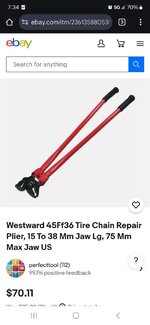getcervid
FNG
- Joined
- Feb 15, 2025
- Messages
- 16
Help me understand your point of view, but as I see it this would not give the best possible traction to 4WD vehicles with open diffs.If you have one set of chains, always chain opposite corners, opposite sides.
I envision this setup running into problems with cross axle traction loss - fairly common to encounter when offroading and suspension flexes out. Opposite side / opposite corners tires lose traction and spin, and you’re stuck.
I have so far found it to be true that power follows the path of least resistance in open diffs. Tires with no traction (resistance) spin.
I envision that keeping one axle chained on both sides is better. Both tires will offer similar resistance (and therefore receive similar power) up until you flex out the suspension pretty extremely and one tire is in the air or nearly in the air.
If you place them on opposite sides and opposite corners, aren’t you:
1. Making it less likely that each tire receives similar power, and therefore experiencing wheel spin more frequently
2. Gambling on the fact that you might encounter a situation where you flex out the vehicle and both of your “naked” tires are hanging in the air/loose snow? Now you have to get traction boards or build up a surface to get a “naked” tire to grip? Or swap chains to that tire? If I only chain up my front or rear axle and get stuck, I must build up snow/dirt or get a chained up tire to catch on a traction board. That seems preferable to me.

